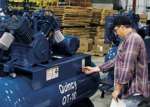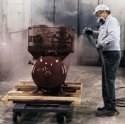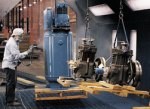Waterborne Paint Handles Demanding Conditions
Quincy Compressor Company finds waterborne paint performs under demanding plant and field conditions...
Some of America's oldest, most successful companies use a distinguishable color to set their products and their businesses apart from competition. John Deere comes to mind, as does Caterpillar, and oh yes, Quincy Compressor.
Unlike "John Deere Green," which singer Joe Diffee memorialized in a top-selling country song, Quincy Blue and Quincy Burgundy are not part of American pop culture, yet. But the company believes that to people who use residential, commercial and industrial air compressors, those colors have come to stand for high quality products and support.
Featured Content
Paint quality is important to Quincy Compressor. Although its products are used mostly in industrial and commercial sites or homeowner's garages, the company believes that a solid, glossy coating on its compressors reinforces the quality message it wants to convey. Occasionally its units are installed outdoors, so the coating must resist heat, sunlight, snow and rain. Since the company does not know exactly where each unit will be used, it applies enough paint to protect all compressor surfaces in any environment. Because of this, it needs a formulation that does not go on too thick and subsequently chip, which would expose the surface to dampness and potential rust.
Anyone comparing a Quincy compressor made five years ago with one made yesterday will see obvious design and feature changes but no noticeable change in the paint. That is on purpose. However, there certainly have been paint changes, and it has resulted in significant benefits to the customer as well as folks who make the compressors in Quincy, Illinois.
All compressors produced during the past three years have been coated with a waterborne paint produced by Finishes Unlimited of Sugar Grove, Illinois. Before then, the company used a solvent-borne coating. Both coatings made the product look good and perform well in the field, but the switch to waterborne paint dramatically lowered VOC levels and reduced coating costs. The company discovered that less paint is required to achieve the same coverage, and waste disposal is also less expensive.
Changeovers in manufacturing operations often result in problems before the true benefits appear. Quincy's conversion from solvent-borne to waterborne paint was no exception. For one thing, Mother Nature had to be satisfied, which was a major challenge.
Quincy is a Mississippi River town in west central Illinois. Its riverside climate drives humidity levels sky high in the summer, when temperatures can top 100F. Winters, of course, are colder and a bit less humid. Regardless of the air temperature or humidity, Quincy uses it to dry the compressors after they are painted. There is only about 15 minutes or so of drying time allotted.
That is because almost all of the plant's production is planned to fill specific orders, so there is a customer waiting for every unit when it is finished. The plant's highly automated production lines usually run at full speed, and compressors need to be shipped as soon as possible after painting.
After cleaning, the smallest compressors are painted in a small tabletop booth. The medium-size conveyors are washed and transported through a hand-spray booth using an overhead conveyor. Within a short time they are labeled and boxed for shipment. Larger units are also hand sprayed in a large stationary booth and sent by dolly to be labeled and readied for shipment.
Fast dry times are critical because there is no real opportunity to lengthen the drying time or go back and repaint marred surfaces. Off loading the units for a short period to allow more drying time would add to the labor cost of the paint line.
Under these circumstances, the company appreciated the fast-dry feature of the solvent-borne paint that left compressors sufficiently dry before the labeling and packing. But, due in part to the solvent-borne paint, the plant's VOC levels were unacceptable to the company and according to the 1990 Clean Air Act guidelines. Quincy decided to significantly lower the VOC levels by switching to waterborne paint. It thought the switch could also reduce the cost associated with removing paint waste, which was becoming a concern.
Quincy's reciprocal air compressors are offered in dozens of sizes and configurations ranging from a 1/3-hp unit measuring 7 × 5 × 10 inches high to large, natural-gas-powered units weighing more than 17,000 lb that are 16 × 7 × 9 ft tall. All but the largest units are fully assembled and performance tested before painting. The gages and controls are masked with tape until the painting is completed. The largest ones are assembled and painted in stages to allow paint crews to achieve the complete coverage on some of the surfaces near the interior of the unit.
Because the company offers a range of features and options on its compressors, each unit entering the paint booth may be different from the previous one. Each has its own combination of curves, crevices, angles and hidden surfaces. Using a preprogrammed, automatic paint booth is out of the question. The only way to achieve a smooth, even coating on every unit is with a staff of skilled painters.
Because compressors are assembled from cast iron, cold-rolled steel, aluminum and copper components, a paint formulation is required that adheres equally well to all of these surfaces.
The large natural gas units present their own challenges. By adapting the paint-and-assemble process, it is possible to gain excellent paint coverage on surfaces that are hidden from view on the interior of the unit while reducing overall finishing and labeling time by about an hour.
When Quincy approached Finishes Unlimited in 1996, its emphasized its dissatisfaction with its prior experience with waterborne paint. The supplier helped Quincy research the problem and reviewed the application process, seasonal drying conditions, environmental goals and field performance specifications. It determined that one of its basic formulations would meet the desired VOC requirements and, with modifications, could match the other performance needs. The formulation would also allow Quincy to satisfy customers who would ask occasionally for custom colors.
To be certain the new paint would perform under the most difficult circumstances, a test was scheduled for the summer months when drying conditions are most difficult. To assure acceptable drying time, paint application specialists recommended some minor process changes to the drying area to provide more air movement over just-coated compressors.
Immediately after Quincy started using the new coating, the painters reported that they were getting coverage levels that surpassed the previous waterborne and solvent-borne coating that had been used. Adhesion tests proved highly satisfactory, and drying times were equal to the drying times of the solvent coatings, so there was no impact on production schedules. The higher solids content of the paint allowed Quincy to coat more square feet of compressor surface per gallon than with the solvent paints, resulting in reduced coating purchase levels.
When solvent paint was used, the company employed a continuously flowing waterwash spray booth to capture overspray. The cost incurred from waste treatment vendors to remove and burn the waste sludge was increasing. When the switch to the waterborne coating was made, the wet system was replaced by a dry system using filters beneath the paint booth floors to absorb overspray. Once they reach the absorption capacity, the filters are allowed to dry and are then compacted and placed into barrels. Since the waste is water-based and not solvent, it can be taken to landfills.
Soon after instituting waterborne coatings at the facility, reports were issued about field rust on the air tanks. A thorough review of the paint line and paint formulation revealed no deficiencies. Then the attention was turned to some of the tanks themselves, which were purchased from an outside vendor.
These arrive at Quincy with a special coating to prevent them from rusting while in the warehouse at the compressor plant. Workers noticed rust on them when they were brought in for production, so Quincy had the manufacturer add more protective coating. After washing, the tanks appeared clean, but in reality small amounts of film remained. The paint initially covered these surfaces, but later it peeled away allowing moisture to get to the surface and create rust. The company identified that the problem was with the preservative rather than the paint, and Quincy decided to steam clean them before the assembly process. Consequently, the problem vanished.
Quincy also earned its ISO 9001 certification. Although coating specifications are not an actual part of the certification, any coating complaints are included in ISO 9001 audits and investigated immediately. The company reports that there have been few problems reported.





















